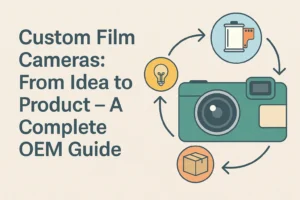Digital Camera vs Film Camera: Which Is Right for You in 2025?
Wondering whether to go digital or analog? You’re not alone. Many creators, collectors, and even brands are comparing digital camera vs film camera setups to find what suits their vision.
This article breaks down the key differences between digital and film cameras—so you can make the best choice for your needs.
📸 1. Image Capture: Pixels vs Grain
| Feature | Digital Camera | Film Camera |
|---|---|---|
| Image Medium | Digital sensor (electronic data) | Light-sensitive film (chemical process) |
| Resolution | Measured in megapixels, often 20–50MP | Depends on film type, up to ~20MP equiv. |
| Look & Feel | Sharp, clean, easily editable | Natural grain, color tone varies by film |
Verdict: Digital wins in precision. Film offers emotion and texture.
💾 2. Workflow: Instant vs Slow Process
- Digital offers instant previews, editing, and sharing
- Film requires developing, scanning, or printing
Is digital camera vs film camera about convenience? Yes—and digital wins there. But film photography offers a more mindful shooting experience.
💰 3. Cost Comparison: Long-term vs Upfront
- Digital camera gear is pricey upfront, but no film cost
- Film cameras are cheaper to buy but add ongoing costs (film, processing)
Tip: If your goal is branding with retro flair, film may offer more emotional value despite the cost.
🧠 4. Creative Experience: Fast Iteration vs Artistic Process
- Digital encourages experimentation and instant feedback
- Film teaches discipline, framing, and patience
In the debate of digital camera vs film camera, think about what you value: speed or soul?
🌐 5. Who Should Choose Which?
| User Type | Best Choice |
|---|---|
| Wedding Photographer | Both (film for style, digital for reliability) |
| Content Creator | Digital for volume, film for storytelling |
| Artist / Collector | Film for uniqueness |
| Brand / Retailer | Film (with OEM) for branding and product lines |
🛠️ Want to Launch a Branded Film Camera?
At WokooCamera, we help businesses create private-label film cameras through OEM/ODM production. Whether you want disposable film cameras for events or reusable film cameras for retail, we’ve got you covered.
Benefits:
- Custom packaging & shell design
- Low MOQs
- Vintage appeal + commercial function
Are you torn between the convenience of digital photography and the timeless charm of film? Now, you don’t have to choose.
Our digital camera that looks like film perfectly blends modern technology with vintage aesthetics, offering:
- Instant preview & easy sharing — No more waiting for film development
- Authentic film-like colors & grain — Capture that nostalgic look without the hassle
- User-friendly controls — Designed for beginners and pros alike
- Lightweight, stylish design — Retro vibe meets modern ergonomics
- We will provide you with our free sample Digital Camera That Looks Like Film, for more details, please see the product picture below.

✅ Final Verdict: Digital Camera vs Film Camera—There’s No Wrong Answer
Both formats have value. Digital is about speed and flexibility. Film is about emotion, branding, and timeless storytelling.
In 2025, analog is more than a format—it’s a business opportunity.
📩 Want to launch your own camera brand? Contact WokooCamera to get started. We also upload some product videos on our Tiktok and Youtube channel, please feel free to check if you interested.



